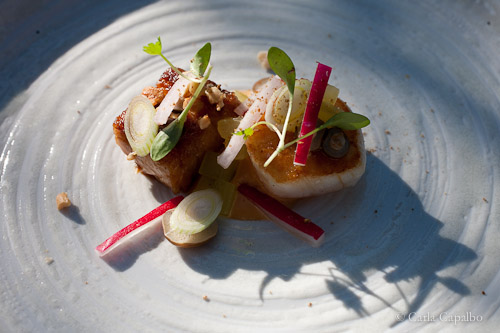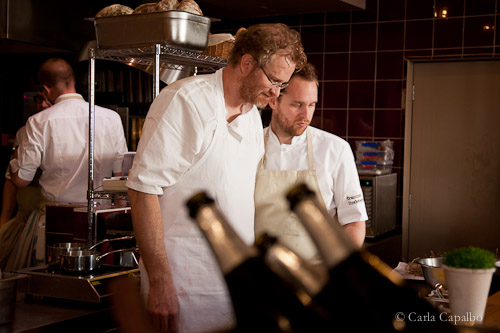Nearing 50
April 14, 2012

Stephen Harris of The Sportsman
They’re counting the days until the awards ceremony of the World’s 50 Best Restaurants are held in London on April 30th. I’ve been thinking about a few of the great UK places I’ve eaten in over the last year or so, restaurants I’ve voted for and would vote for again that express their terroirs and excite the palate.

The sea by The Sportsman
Taking a day trip from London to The Sportsman for lunch is as good as going on holiday. This isolated pub stands alone by the wide tidal beaches of the Thames estuary near Whitstable in an area known appropriately as Seasalter. Stephen Harris’ cuisine of pure, decisive flavours and home-cured ingredients fits perfectly into this unfrilly, unstuffy environment. The large white pub he runs with his wife, Emma, is just metres from the dyke. Beyond it is nothing but sea, with miles of flat watery mud for foraging sea-salty greens. Stephen was an amateur cook who trained in a few restaurants before setting out “to cook food as good as the best chefs’, stripping away the bells and whistles, with no sommeliers, no bullshit. Just food of that quality.” He’s moved beyond that and engaged with the local farmers, raising lambs on the salt marshes and curing whole pigs from tail to toe. Fishermen call him directly with a line-caught 10-kilo turbot or a clutch of fresh crabs.

Crab risotto

The Sportsman’s sliced wigeon
The blackboard menu changes daily, reflecting those impromptu arrivals. It offers more traditional pub fare as well as the multi-course tasting menu the foodies come for and that must be ordered in advance. Stephen takes you through a series of dishes, large and small, that reflect the land and seascapes as clearly as the vast sea there reflects the sky. In winter, a sharp bite of pickled herring with Bramley apple jelly and buttered soda bread readies the palate for Whitstable oysters with home-cured ham, followed by battered turbot skirt, and a creamy textured risotto richly imprinted with the flavours and colours of local brown crabs. It’s topped with their pale, delicate meat. Wigeon shot near Faversham is lightly smoked nearby. This dabbling wild duck has a fine gaminess that domestic duck can’t attain, and he pairs it well with Puy lentils, and hot-and-sweet quince and mustard sauce. The menu powers on through braised turbot, roast saddle of lamb, and great desserts, the best of British. There’s a relaxed, mix-and-match atmosphere to the dining rooms, and a fine wine list to accompany the food, so go by train.

Sat Bains close to his restaurant
If instead you take the train north from London you can be in Nottingham in under two hours. Talented young chef Sat Bains and his wife, Amanda, have turned an unpromising site on the outskirts of town – in an industrial park under a flyover – into a wonderfully comfortable, finely tuned ‘restaurant with rooms’ that recently earned its second Michelin star. Sat’s got charisma and flair and cooks using ingredients sourced both locally and further afield in the UK. “British food was always a magpie food, pinching a little from here and there to spice itself up, and our menu reflects that cross-cultural character,” he says. From a Punjab family, Sat was brought up in Derby. Once he discovered his love for cooking, his ‘angry young man’ beginnings helped him win competitions and gave him the determination to take over the then floundering eatery. The couple transformed it and the food, and Sat has inspired other young chefs from the Midlands to leave their stamp on the modern British food scene.

Sat Bains’ scallop and pork belly

Sat’s rhubarb and custard dessert
Sat offers tasting menus of seven and ten courses. In early spring these include dishes created around scallops, Cornish crab, artichokes, fallow deer, rhubarb, treacle sponge, and sea buckthorn. Sat likes to bring out the distinctive flavours of each by exploring their textures and five tastes. A large roast scallop from Skye is paired with succulent pork belly, topped with a microcosm of Lilliputian mushrooms, pickled cucumber, and coriander seeds, and served with saté sauce and teriyaki. One of the desserts has hibiscus-poached rhubarb accompanied by caramelized egg custard in a soft quenelle. Vaut le voyage!

Chef Mikael Jonsson (centre) at Hedone
Hedone, one of London’s newest and most ambitious restaurants has opened in Chiswick, in west London. Swedish Mikael Jonsson is a self-taught chef who earned a reputation as a serious food critic long before he started cooking. Until very recently he was prevented from spending time in the kitchen by severe food allergies. Now that he’s resolved that problem – by going on a Paleolithic diet that is gluten, wheat and sugar-free – he’s launched into Hedone, no mean feat for a man of un certain age. Mikael’s near-obsessive knowledge about raw materials leads him to work with very special produce, from salt-marsh lamb to Japanese deer that are now found in south-west England and that have been killed with just one shot to the head so as to leave their meat stress-free. Jonsson’s dishes have a pure, pared-down aesthetic that has been proving too extreme for some London critics. But fans of food with true taste, texture and a compelling cultural backbone hail him as a rising star.

Jonsson shows a customer the lamb before cooking

The finished lamb dish
Out of Bordeaux
Is April really the cruellest month? It never feels that way to me, with spring finally in the air and in the gardens. It’s in Bordeaux’s vineyards too, as last week at the Primeurs tastings showed. Vine buds were breaking up and down the Médoc. The hail storm that came on just as we were leaving Bordeaux did have an element of menace about it, though, a hard rain falling after such a long dry winter.

First storm over the vineyards of Margaux in the Médoc





